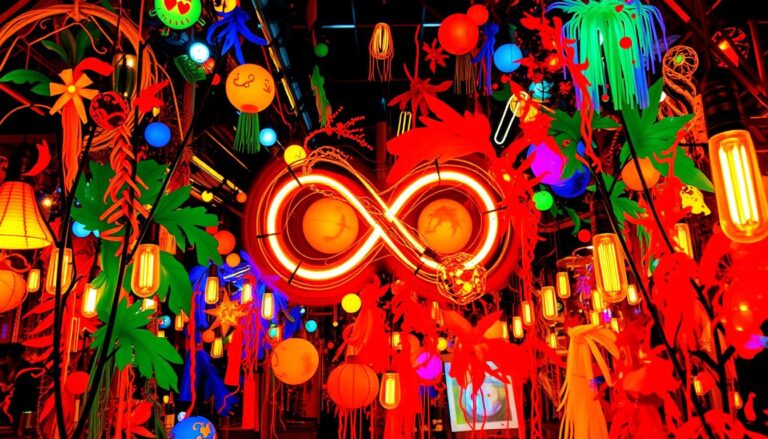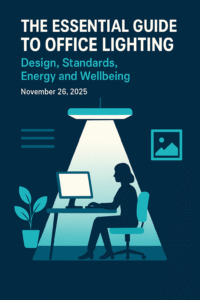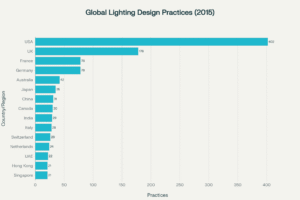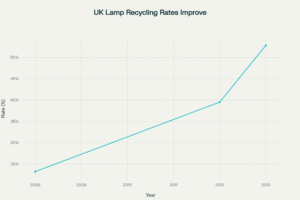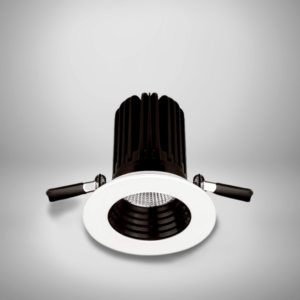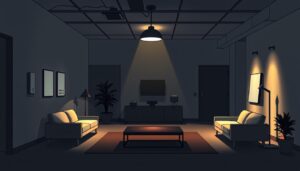The lighting industry is undergoing a transformative shift, and we’re at the forefront of this change. The introduction of the British Standard BS 8887-221:2024 marks a significant moment in our journey towards a circular economy in lighting. This standard is more than a guideline; it’s a call to action for sustainable lighting solutions. It prioritises longevity, efficiency, and environmental responsibility.
At Lumenloop, we’ve always championed lighting design best practices that transcend mere functionality. Our mission is to close the loop on the lighting industry, ensuring every luminaire we produce is 100% regenerative and refurbishable. The new standard aligns perfectly with our vision, setting the stage for a future where lighting-related e-waste is eliminated entirely.
This isn’t simply about compliance; it’s about rethinking how we design, manufacture, and recycle lighting. By embracing circular economic principles, we’re not only reducing waste but also creating lighting solutions that are smarter, more sustainable, and built to last. Together, we can illuminate a brighter, greener future.
Understanding the Global Shift Towards Circular Economics
The linear economy, characterised by take, make, dispose, is flawed. It has led to resource depletion, waste mountains, and environmental degradation. At Lumenloop, we advocate for a change in how we design, produce, and consume. The transition to a circular economy is imperative, not just a trend. For the lighting sector, this entails adopting Circular lighting standards, focusing on Lighting e-waste reduction, and exploring Remanufacturing in lighting.
The Linear Economy Problem
The linear economy thrives on single-use products and planned obsolescence. In lighting, this results in millions of discarded luminaires annually, contributing to landfill waste and carbon emissions. The World Resources Institute estimates that 45% of global greenhouse gas emissions are linked to product use and manufacturing. This unsustainable system is on the brink of collapse.
Defining Circular Economic Principles
Circular economics offers a different approach. It focuses on:
- Designing for longevity and durability
- Reusing and refurbishing products
- Recycling materials to close the loop
At Lumenloop, we adhere to these principles, ensuring our products are regenerative by design.
Why the Lighting Industry Must Adapt
The lighting industry stands at a critical juncture. With growing regulatory pressures and consumer demand for sustainability, old practices are no longer viable. By embracing Circular lighting standards, we can significantly reduce Lighting e-waste reduction and promote Remanufacturing in lighting.
The Environmental Impact of Traditional Lighting Solutions
Traditional lighting solutions have long been the default choice, but their environmental toll is undeniable. High energy consumption, short lifespans, and non-recyclable materials contribute significantly to lighting e-waste reduction challenges. These systems often end up in landfills, where they leach harmful chemicals into the soil and water. It’s a cycle that’s as inefficient as it is damaging.
- Traditional lighting consumes more energy, increasing carbon footprints.
- Short lifespans mean frequent replacements, driving up resource use.
- Non-recyclable components make disposal a logistical and environmental nightmare.
At Lumenloop, we believe in sustainable lighting solutions that break this cycle. Our approach focuses on longevity, modularity, and recyclability. By designing luminaires that last longer and can be easily refurbished, we’re tackling lighting e-waste reduction head-on.
As climate change continues, the shift to sustainable lighting isn’t just an option; it’s a necessity. Traditional methods are no longer viable in a world striving for environmental balance. We’re here to lead the change, one luminaire at a time.
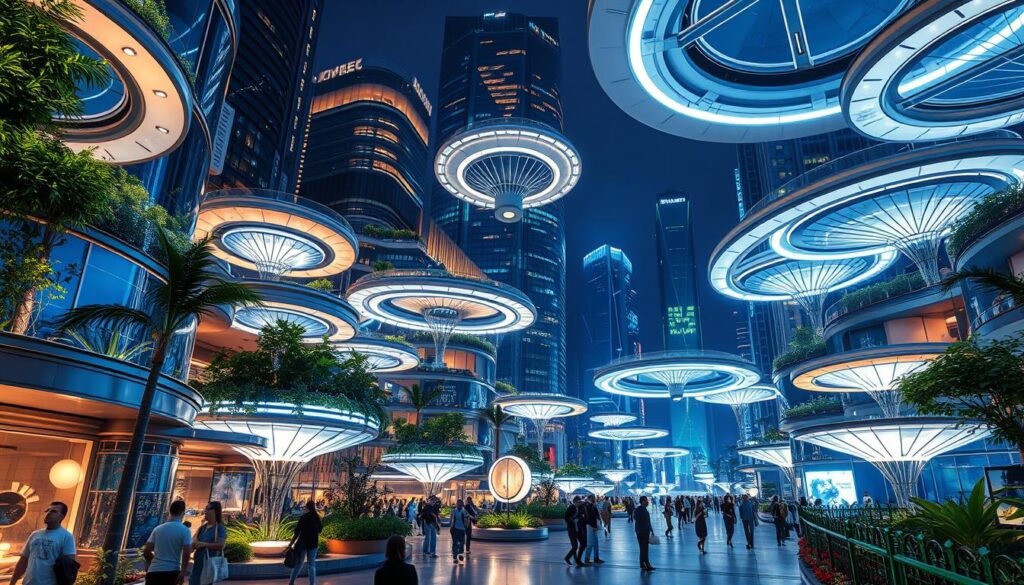
Circular Economy in Lighting: A New Paradigm
At Lumenloop, we see lighting as more than a necessity—it’s a chance for regeneration. The move towards circular lighting standards is imperative, not just a fleeting trend. By reimagining the design, construction, and recycling of lighting systems, we’re charting a course for a greener tomorrow.
Design for Longevity
Our core principle is to craft products that endure. We aim for luminaires that stand the test of time, reducing waste and the need for constant replacements. This aligns with the BS 8887-221:2024 standard, which advocates for design and disassembly.
Modular Components
Modular lighting components are a breakthrough. They enable simple repairs and upgrades, extending the life of lighting systems. This means you can replace individual parts instead of the whole fixture, conserving resources and cutting costs.
Material Recovery Systems
At the end of a product’s life, our material recovery systems ensure nothing is discarded. We design for disassembly, allowing materials to be reused in new products. This closed-loop system minimises electronic waste and fosters a circular economy.
By adopting these principles, we’re not just innovating—we’re transforming the lighting sector. Together, we can light the way to a sustainable future.
Breaking Down Lumenloop's Sustainable Standard
At Lumenloop, we’re redefining the creation of lighting solutions. Our mission is to make every luminaire 100% regenerative and refurbishable. This isn’t just a goal; it’s our standard. We advocate for a Circular Economy in Lighting, where waste is eliminated, and resources are endlessly reused.
So, how do we achieve this? It begins with design. Our refurbishable luminaires are designed to last and evolve. Here’s what makes our approach unique:
- Modular Design: Every component is replaceable, reducing the need for complete replacements.
- Material Recovery: We ensure materials can be reclaimed and reused, closing the loop on waste.
- Smart Technology: Integration of future-proof systems allows for easy upgrades and maintenance.
The benefits are twofold. Environmentally, we’re cutting down on e-waste and conserving resources. Economically, businesses save on long-term costs with durable, upgradable lighting systems. It’s a win-win for the planet and your bottom line.
We’re not just creating lighting; we’re crafting a sustainable future. With Lumenloop, every luminaire is a step towards a brighter, greener world.
Innovation in Refurbishable Luminaire Design
At Lumenloop, we believe lighting should evolve with the times. Our refurbishable luminaires are designed to adapt, ensuring they remain efficient and relevant for years. By focusing on smart integration, ease of maintenance, and future-proof technologies, we’re redefining lighting design best practices.
Smart Component Integration
Our luminaires feature modular components that can be easily upgraded or replaced. This approach not only extends the product’s lifespan but also reduces waste. With smart integration, we ensure performance remains optimal, even as technology advances.
Maintenance-Friendly Features
We’ve prioritised simplicity in our designs. Tool-free disassembly allows for quick repairs and part replacements, minimising downtime. This user-friendly approach makes our refurbishable luminaires a practical choice for facility managers and engineers.
Future-Proof Technologies
Our luminaires are built to adapt to emerging trends. From energy-efficient LEDs to smart lighting systems, we ensure our products stay ahead of the curve. By investing in future-proof technologies, we help businesses stay sustainable without constant replacements.
At Lumenloop, we’re committed to closing the loop on lighting. Our refurbishable luminaires are more than just products—they’re a step towards a circular economy in lighting design.
The Economic Benefits of Circular Lighting Solutions
At Lumenloop, we hold that sustainable lighting solutions are not just eco-friendly—they also boost your profits. The adoption of circular lighting standards is reshaping the lighting industry. It brings about notable economic gains, alongside environmental advantages.
- Reduced material costs: Our luminaire designs focus on longevity and modularity. This approach minimises the need for frequent replacements, saving on material expenses.
- Lower energy consumption: Our energy-efficient designs cut down operational costs. This helps businesses save on electricity bills.
- Decreased waste disposal expenses: With our refurbishable luminaires, we eliminate the need for costly waste management. This keeps more money in your pocket.
Our case studies demonstrate that businesses adopting circular lighting standards experience a clear return on investment. By extending product lifespans and reducing waste, we assist companies in achieving both financial and sustainability goals. It transcends mere lighting—it’s about forging a smarter, more cost-effective future.
Implementation Strategies for Businesses
Adopting circular lighting solutions is more than just replacing old fixtures. It’s a strategic move that demands careful planning and execution. At Lumenloop, we’ve witnessed how businesses can revamp their lighting systems. This aligns with the BS 8887-221:2024 standard. Here’s how to begin.
Assessment and Planning
Start by examining your current lighting setup. Identify areas for improvement in Lighting supply chain sustainability. Are there fixtures that can be upgraded or replaced with modular designs? A detailed assessment is key to finding opportunities for circularity. This ensures your transition is both efficient and impactful.
Retrofit Considerations
Retrofitting existing systems is often the most cost-effective option. Remanufacturing in lighting allows you to reuse components, cutting down on waste and costs. Seek out luminaires that can be easily disassembled and refurbished. This approach not only extends their lifespan but also supports your sustainability objectives.
ROI Calculations
Circular lighting benefits both the environment and your finances. Calculate the return on investment by considering energy savings, reduced maintenance costs, and possible rebates. Many businesses discover that the initial investment yields returns faster than anticipated. This makes it a financially savvy choice.
Meeting UK Sustainability Targets Through Circular Lighting
The UK has set ambitious sustainability targets, aiming to reduce carbon emissions and minimise waste across industries. Circular Economy in Lighting plays a key role in achieving these goals. By rethinking how we design, use, and dispose of lighting, we can significantly cut down on environmental impact while meeting regulatory standards.
At Lumenloop, we’re committed to helping businesses align with these targets. Our approach focuses on Lighting e-waste reduction through innovative, sustainable solutions. Here’s how we’re making a difference:
- Design for Longevity: Our luminaires are built to last, reducing the need for frequent replacements and minimising waste.
- Modular Components: Easy-to-replace parts ensure that products can be refurbished instead of discarded.
- Material Recovery Systems: We prioritise recyclable materials, ensuring that end-of-life products are repurposed instead of landfilled.
Transforming the Supply Chain
For circular lighting to thrive, the supply chain must evolve. It’s not just about sourcing materials responsibly. It’s also about ensuring every component can be recovered, refurbished, and reused. At Lumenloop, we’re rethinking the lighting supply chain sustainability, from start to finish.
Sustainable Sourcing
We start with the materials. Modular lighting components are designed to last. They must also come from ethical and sustainable sources. Our approach includes:
- Partnering with suppliers who prioritise renewable resources.
- Using materials that are easy to recycle or repurpose.
- Ensuring transparency in every step of the sourcing process.
Reverse Logistics
When a luminaire reaches the end of its life, the journey isn’t over. Reverse logistics is the backbone of a circular economy. We’ve built systems to:
- Collect used lighting products efficiently.
- Refurbish and upgrade components for reuse.
- Minimise waste by recovering valuable materials.
By transforming the supply chain, we’re not just reducing waste. We’re creating a system where every part of a luminaire has a second, third, or even fourth life. It’s how we’re closing the loop on lighting.
Measuring Success: Key Performance Indicators
At Lumenloop, we believe in making progress measurable. Tracking the success of circular lighting standards isn’t just about numbers—it’s about creating a tangible impact. To help businesses evaluate their efforts, we’ve identified key performance indicators (KPIs) that align with sustainable lighting solutions.
- Waste Reduction: How much lighting-related e-waste has been diverted from landfills through refurbishment and recycling?
- Energy Savings: What’s the reduction in energy consumption achieved by switching to energy-efficient, circular lighting systems?
- Cost Efficiency: Are businesses seeing a return on investment through reduced maintenance and material costs?
Conclusion: Illuminating the Path to a Sustainable Future
The transition to a circular economy in lighting is imperative, not just a dream. At Lumenloop, we’re dedicated to revolutionising the lighting sector. Our aim is to eradicate lighting-related e-waste by creating luminaires that are truly regenerative.
Refurbishable luminaires symbolise innovation and embody our commitment to sustainability through modular designs and efficient material recovery systems. This strategy not only minimises waste but also supports the UK’s stringent sustainability goals.
The transition to a circular economy in lighting begins with a single action. Let’s embark on this journey together. Discover how Lumenloop’s offerings can guide you towards a sustainable future.
FAQ
What is the new standard that sets the stage for a circular economy in lighting?
The new standard introduces principles and innovations for a circular economy in lighting. It focuses on reuse, refurbishment, and recycling. This aims to reduce waste and promote sustainability.
How does the circular economy differ from the traditional linear economy?
The linear economy depletes resources and generates waste. In contrast, the circular economy promotes reuse, refurbishment, and recycling. It aims to close the loop and eliminate waste.
Why must the lighting industry adapt to a circular economy?
The lighting industry must adapt to a circular economy to address environmental issues. Traditional lighting solutions have high energy consumption and short lifespans. They also pose challenges in disposing of non-recyclable materials.
What are the key principles of circular lighting?
Circular lighting’s key principles include design for longevity and modular components. It also involves material recovery systems. These enable longer product lifespans, easier repair and upgrades, and the reuse of materials.
How does Lumenloop’s sustainable standard address the principles of circular lighting?
Lumenloop’s sustainable standard focuses on designing luminaires for full refurbishment and regeneration. It uses processes and technologies for efficient performance, easy upgrades, and tool-free disassembly. This ensures future-proof solutions.
What are the economic benefits of adopting circular lighting solutions?
Adopting circular lighting solutions offers economic benefits. These include reduced material costs, lower energy consumption, and decreased waste disposal expenses. Lumenloop’s case studies demonstrate these advantages.
How can businesses implement circular lighting strategies?
Businesses can implement circular lighting strategies through assessment and planning. They should consider retrofitting existing lighting systems and calculate ROI to demonstrate financial benefits. Lumenloop offers expertise in these areas.
How does circular lighting align with UK sustainability goals?
Circular lighting aligns with UK sustainability goals, such as reducing carbon emissions and minimising waste. Lumenloop’s innovative, sustainable lighting solutions help businesses meet these targets.
How must the supply chain evolve to support circular lighting?
The supply chain must evolve to support circular lighting. It needs sustainable sourcing of materials and reverse logistics for recovering and refurbishing used luminaires. Lumenloop’s approach to supply chain sustainability is key.
What key performance indicators should businesses use to measure the success of their circular lighting efforts?
Businesses should use KPIs like waste reduction, energy savings, and cost reductions to measure success. Lumenloop provides tools and methodologies for tracking these metrics.
